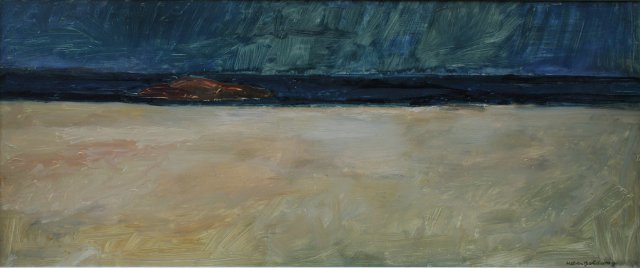Hilda Goldwag (1912 - 2008)
Hilda Goldwag was born in Vienna on April 28th 1912. She died in Glasgow on January 28th 2008 in her 96th year. The intervening years saw a world of upheaval that affected the young daughter of a Jewish family utterly. Her relatives' experiences were to imbue her paintings with a profound sadness - and many elements of joy without which her life would have been unliveable. Hilda's father Moses Leopold Goldwag died when she was nine. He was an artist and gallery owner. Her mother, Szerena was left with three children. Hilda's talent was noted at an early age and she attended the Anna Schantruck Art Classes for gifted children - and was one of those chosen at fourteen to paint murals in a new kindergarten. In 1938 she graduated with an arts degree at the GraphiscmeStaatsclemtr und Versuchs Anmalt in Vienna. In March 1939 Hilda left Vienna and travelled to Edinburgh, through a permit obtained by the wife of Professor Max Born, the Nobel Prize winning physicist, whose daughter Gritli was a student friend in Vienna. Permits were obtained for Hilda's family to leave Austria but they arrived the day war was declared. They were stranded - and all of them mother, brother, sister, brother-in-law (and their son Paul who was 8 months old when she left for Scotland) perished in the Holocaust, probably in Dachau in 1943. During the war Hilda worked at McGlashan's engineering factory in Glasgow where, due to her alien status she had been forced to move from Edinburgh. After Hilda's war work, she became, in 1945 head designer for Frielanders in Hillington, where she designed headscarves for Marks and Spencer, their main customers. This ended in 1955 when she did freelance design work, including book illustration for Collins (among them Robert Louis Stevenson's "A Child's Garden of Verses") and other publishers. She also worked part time as an occupational therapist at Foresthall, a home for elderly and mentally incapacitated patients. Hilda painted mainly in oils, on board and she mostly painted on the spot with a pallet knife rather than brushes. Most of her work was done in the Glasgow area, but she did travel on holiday to Italy, Holland and the islands of Scotland. Her paintings are usually large and dramatic. It is amazing that Hilda Goldwag was able to see any happiness in her views of her world. Others would have been blighted by the knowledge (that never left her) of the fate meted out to all the members of her family during the Holocaust.




